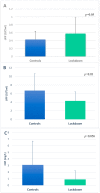COVID-19 Lockdown in Israel: The Environmental Effect on Ultrafine Particle Content in the Airway
- PMID: 35564902
- PMCID: PMC9105301
- DOI: 10.3390/ijerph19095507
COVID-19 Lockdown in Israel: The Environmental Effect on Ultrafine Particle Content in the Airway
Abstract
Inhaled ultrafine particle (UFP) content in exhaled breath condensate (EBC) was observed as an airway inflammatory marker and an indicator of exposure to particulate matter (PM). The exceptional decline in air pollution during the COVID-19 lockdown was an opportunity to evaluate the effect of environmental changes on UFP airway content. We collected EBC samples from 30 healthy subjects during the first lockdown due to COVID-19 in Israel (March-April 2020) and compared them to EBC samples retrieved during April-June 2016 from 25 other healthy subjects (controls) living in the same northern Israeli district. All participants underwent EBC collection and blood sampling. Ambient air pollutant levels were collected from the Israeli Ministry of Environmental Protection's online database. Data were acquired from the monitoring station closest to each subject's home address, and means were calculated for a duration of 1 month preceding EBC collection. UFP contents were measured in the EBC and blood samples by means of the NanoSight LM20 system. There was a dramatic reduction in NO, NO2, SO2, and O3 levels during lockdown compared to a similar period in 2016 (by 61%, 26%, 50%, and 45%, respectively). The specific NO2 levels were 8.3 ppb for the lockdown group and 11.2 ppb for the controls (p = 0.01). The lockdown group had higher UFP concentrations in EBC and lower UFP concentrations in serum compared to controls (0.58 × 108/mL and 4.3 × 108/mL vs. 0.43 × 108/mL and 6.7 × 108/mL, p = 0.05 and p = 0.03, respectively). In this observational study, reduced levels of air pollution during the COVID-19 lockdown were reflected in increased levels of UFP airway contents. The suggested mechanism is that low airway inflammation levels during lockdown resulted in a decreased UFP translocation to serum. Further studies are needed to confirm this hypothesis.
Keywords: COVID-19; EBC; NO2; UFP; air pollution; lockdown.
Conflict of interest statement
The authors declare no conflict of interest.
Figures



Similar articles
-
Cardiorespiratory biomarker responses in healthy young adults to drastic air quality changes surrounding the 2008 Beijing Olympics.Res Rep Health Eff Inst. 2013 Feb;(174):5-174. Res Rep Health Eff Inst. 2013. PMID: 23646463 Free PMC article.
-
Cigarette-related cadmium and environmental pollution exposure are reflected in airway ultrafine particle content.ERJ Open Res. 2020 Sep 14;6(3):00361-2019. doi: 10.1183/23120541.00361-2019. eCollection 2020 Jul. ERJ Open Res. 2020. PMID: 32963996 Free PMC article.
-
Ultrafine particle content in exhaled breath condensate in airways of asthmatic children.J Breath Res. 2015 Apr 1;9(2):026001. doi: 10.1088/1752-7155/9/2/026001. J Breath Res. 2015. PMID: 25830607
-
Assessment of air pollution status during COVID-19 lockdown (March-May 2020) over Bangalore City in India.Environ Monit Assess. 2021 Jun 8;193(7):395. doi: 10.1007/s10661-021-09177-w. Environ Monit Assess. 2021. PMID: 34105059 Free PMC article.
-
Lockdown Amid COVID-19 Ascendancy over Ambient Particulate Matter Pollution Anomaly.Int J Environ Res Public Health. 2022 Oct 19;19(20):13540. doi: 10.3390/ijerph192013540. Int J Environ Res Public Health. 2022. PMID: 36294120 Free PMC article. Review.
References
-
- WHO Air Pollution. [(accessed on 1 September 2020)]; Available online: http://www.who.int/airpollution/en/
-
- Li N., Georas S., Alexis N., Fritz P., Xia T., Williams M.A., Horner E., Nel A. A work group report on ultrafine particles (American Academy of Allergy, Asthma & Immunology): Why ambient ultrafine and engineered nanoparticles should receive special attention for possible adverse health outcomes in human subjects. J. Allergy Clin. Immunol. 2016;138:386–396. - PMC - PubMed
Publication types
MeSH terms
Substances
LinkOut - more resources
Full Text Sources
Medical
Miscellaneous

